No. 12 Squadron RAF
| No. 12 Squadron RAF | |
|---|---|
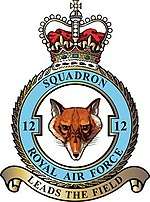 | |
| Active |
14 February 1915 – 31 March 2014 9 January 2015 – 14 February 2018 24 July 2018 – present |
| Country |
|
| Branch |
|
| Type | Joint British/Qatari training squadron |
| Role | Multi–role combat |
| Part of | No. 1 Group RAF |
| Home station | RAF Coningsby (from 2019) |
| Motto(s) | "Leads the Field"[1] |
| Aircraft | Eurofighter Typhoon FGR4/T3 (from 2019) |
| Battle honours |
|
| Insignia | |
| Squadron badge | A fox's mask |
| Squadron badge heraldry | Based on a suggestion when the squadron was equipped with the Fairey Fox, an aircraft of which they were the sole operators. |
| Squadron roundel |
 |
No. 12 Squadron is a flying squadron of the Royal Air Force (RAF). The squadron reform in July 2018 as a joint RAF/Qatari Emri Air Force squadron. From 2019 it is expected to be based at RAF Coningsby in Lincolnshire and operate the Eurofighter Typhoon, temporarily integrating Qatari air and ground crews in order to provide training and support as part of the Qatari purchase of 24 Typhoons from the UK.
History
_162.jpg)
No. 12 Squadron Royal Flying Corps (RFC) was formed in February 1915 from a flight of No. 1 Squadron RFC based at Netheravon Airfield in Wiltshire. The squadron moved to France in September 1915 and operated a variety of aircraft on operations over the Western Front during the First World War. In March 1918, the squadron was re-equipped with the Bristol F.2b Fighter just before becoming part of the newly formed Royal Air Force. The squadron, by then based at Bickendorf in Germany, was disbanded in 1922.
The squadron re-formed at RAF Northolt in West London on 1 April 1923, operating the de Havilland DH.9A. In 1924, it moved to RAF Andover in Hampshire and converted to the Fairey Fawn, a single-engined biplane bomber. The Fawns were replaced in 1926 with the Fairey Fox, which influenced the adoption of the fox's head as part of the squadron badge and the squadron's motto. The squadron was the only RAF user of the Fairey Fox and its performance was superior to other types, resulting in the motto of 'Leads the Field'. In 1931, the squadron re-equipped with the Sydney Camm designed Hawker Hart. In October 1935 the squadron moved to the Middle East, but returned to Andover in August 1936. The Harts were replaced by the Hawker Hind in 1936 and in 1938 the squadron was equipped with Fairey Battles.
On the first day of the Second World War the squadron moved to France to begin operations. On 12 May 1940, over the Albert Canal, Belgium, one bridge in particular was being used by the invading German Army, with protection from fighter aircraft, anti-aircraft and machine-guns. The RAF was ordered to demolish this vital bridge, and five Fairey Battles from the squadron were dispatched. They met an intensive anti-aircraft fire, but the mission was accomplished, much of the success being due to the coolness and resource of the pilot Flying Officer Garland of the leading aircraft and the navigation of Sergeant Gray. Notwithstanding the success of the mission, the leading aircraft and three others did not return. Flying Officer Garland and Sergeant Gray were both posthumously awarded the Victoria Cross.
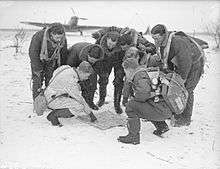
No. 12 Squadron returned to England in June. It was stationed initially at RAF Finningley in South Yorkshire, before moving to RAF Binbrook in Lincolnshire during July 1940, when it was refurnished with Battles. Amongst other missions, the squadron carried out anti-invasion strikes against shipping in Boulogne Harbour in northern France, most notably on 17 and 19 August. The squadron was one of the last No.1 Group units to conduct operations with Fairey Battles. These took place on 15/16 October 1940, when No. 301 (Polish) Squadron bombed Boulogne and Nos. 12 and 142 Squadrons bombed Calais.
By November 1940, the squadron had been re-equipped with the Vickers Wellington medium bomber, remaining for the time being at RAF Binbrook. The squadron moved again in 1942, to RAF Wickenby also in Lincolnshire, and soon after converted to operate the Avro Lancaster a heavy bomber. In 1946 the squadron re-equipped with the Avro Lincoln, another heavy bomber. In 1952, the squadron joined the jet-age and re-equipped with the English Electric Canberra jet bomber. After 44 years continuous service the squadron was again disbanded in July 1961. In 1962, the squadron was re-formed to operate eight Avro Vulcan V bombers equipped with Yellow Sun one megaton free-fall strategic nuclear bombs for medium to high altitude release. The squadron initially operated Vulacns from RAF Coningsby in Lincolnshire and then later from RAF Cottesmore in Rutland. The advent of effective Soviet surface-to-air-missiles made high-flying bombers vulnerable, and in late 1966 the squadron took delivery of eight WE.177B strategic nuclear laydown bombs for low-level penetration missions. It was assigned to Supreme Allied Commander Europe (SACEUR) as part of the UK strategic nuclear forces deployed with that 450 kt weapon, that was intended as a temporary stop-gap until the UK Polaris force began to take over the strategic nuclear delivery role.[2] The squadron stood down from this role at the end of 1967.[3][4]. It was then intended to re-form the squadron with the BAC TSR-2 and then the General Dynamics F-111K but both acquisitions were cancelled by the British Government.[5]
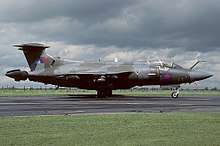
No.12 Squadron was eventually re-formed at RAF Honington in Suffolk in October 1969 with twelve Blackburn Buccaneer aircraft assigned to Supreme Allied Commander Atlantic (SACLANT) in the anti-shipping role, equipped with twelve WE.177 nuclear bombs and free-falling conventional high explosive bombs,[6] and from 1974 with Martel missiles for non-nuclear strike.
During the late 1970's the squadron featured in the RAF documentary film 12 Squadron Buccaneers, produced by the Central Office of Information. The film features the squadron's deployment from Honington to RAF Gibraltar in the Mediterranean for NATO exercise Open Gate, where they carry out a low-level anti-shipping mission.[7][8]
The squadron moved to RAF Lossiemouth in Morayshire during 1980, still in the same anti-shipping role.[9]
During the 1991 Gulf War, personnel from all three Buccaneer squadrons at Lossiemouth, including No. 12 Squadron, took part in Operation Granby, the aircraft's first combat operation.[10] Following a short-notice decision to deploy to the Middle East, the first batch of six aircraft were brought to readiness in under 72 hours, including the adoption of desert-pink camouflage and additional war-time equipment. The first six aircraft departed from Lossiemouth for Muharraq in Bahrain at 04:00 on 26 January 1991. Twelve Buccaneers operated as target designators and it became common for each attack formation to comprise four Tornados and two Buccaneers; each Buccaneer carrying a Pave Spike laser designator pod, one as a spare in case of equipment failure.[10] The Buccaneer force became known as the 'Sky Pirates' in reference to the maritime history of the Buccaneer. Each aircraft had a Jolly Roger flag painted on its port side, alongside nose art featuring female characters. In recognition of their Scottish roots, the Buccaneers were also named after Speyside whisky such as Glenfiddich, Glen Elgin and The Macallan.[11] Hostilities ended in late February 1991, the Buccaneers having flown 218 sorties without loss, designating targets for other aircraft and later dropping 48 Paveway II laser-guided bombs.[12]
In October 1993, the squadron retired its Buccaneers.[13]
Panavia Tornado: 1993 – 2018
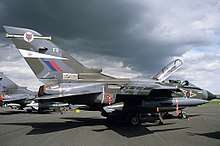
In September 1993, No. 27 Squadron, then based at RAF Marham in Norfolk, disbanded and immediately re-formed as No.12 Squadron operating twelve Panavia Tornado GR1B aircraft and relocated to RAF Lossiemouth. The squadron was equipped with eighteen WE.177 nuclear weapons[14]
During December 1998, the squadron took part in Operation Desert Fox, the four-day air campaign against Iraq. Deployments to the Persian Gulf continued, flying the upgraded Tornado GR4 from 2001, and included major contributions in 2003 as part of Operation Telic as well as supporting the first free elections in Iraq for 50 years in January 2005. In 2006 and again in 2008 the squadron provided armed overwatch for UK and US ground operations in Iraq. Shortly afterwards, as British troops withdrew from the country, the Tornado fleet based in the region also returned to the UK, marking the end of a long era of the aircraft in theatre.[15]
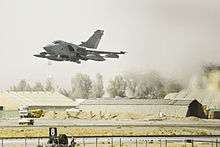
In June 2009, the squadron deployed ten jets to Cyprus, eight of which continued to Kandahar in Afghanistan. This marked the start of Tornado GR4 operations in Afghanistan, with the type replacing the Harrier GR9 in theatre. For over four months, No. 12 Squadron successfully provided support to the International Security Assistance Force (ISAF), including close air support for, amongst others, British, American, Canadian and Afghan troops in all parts of the country. On 16 October 2009, No. 12 Squadron returned to Lossiemouth after having handed over to a Marham-based GR4 squadron.
Between subsequent Operation Herrick deployments during 2011, No. 12 Squadron was deployed in support of Operation Ellamy, the UK’s participation in the military intervention in Libya under United Nations Security Council Resolution 1973. This saw ten aircrew deploy to Gioia del Colle in southern Italy to bolster the Tornado component during the peak of operations. The remainder of the squadron was held at readiness to move to RAF Marham to launch Storm Shadow raids on hardened Libyan targets. These missions required three air-to-air refuelling brackets on the outward journey and one further on return to Gioia Del Colle.
The squadron disbanded on 31 March 2014 under the command of Wing Commander Simon Strasdin.[16][17][18]
.jpg)
Having redeployed from Afghanistan as part of Operation Herrick, No. 2 Squadron equipped with eight Tornado GR4's was deployed to RAF Akrotiri in Cyprus as part of Operation Shader, a coalition undertaking air strikes against the Islamic extremist group ISIL in Iraq.
All Tornado aircraft were due to be withdrawn from RAF operations by the end of 2015. Consequently, No. 2 Squadron was expected to stand down on 31 March 2015 as a Tornado squadron at RAF Marham, and reactivate the following day as a Eurofighter Typhoon squadron at RAF Lossiemouth.[19] However, in October 2014, Prime Minister David Cameron announced that No.2 Squadron's disbanding and reformation would be put on hold to allow Tornados to continue to support operations against ISIL. As a consequence, the new No. 2 Squadron formed at Lossiemouth on 12 January 2015, and No. 12 Squadron re-formed the same day at RAF Marham, taking over the former Tornado aircraft and assets of No.2 Squadron.[20][21] The re-formed squadron is commanded by Wing Commander Nikki Thomas, the first female RAF officer to command a fast jet squadron.[22]
In August 2015, Jane's reported that the squadron will stay active for a longer period.[23]
In September 2016, No. 12 Squadron was deployed to Syria for reconnaissance of ISIS troop movements.
The squadron's last mission operating the Tornado took place on 14 December 2017 in the skies over Iraq and Syria. As part of the draw-down of the RAF's Tornado fleet, the squadron disbanded on 14 February 2018, 103 years after it first formed. Squadron personnel were re-assigned to Marham's other Tornado squadrons, No. 9 Squadron and No. 31 Squadron and the squadron standard was returned to RAF College Cranwell.[24]
Role and operations
On 14 December 2017, it was announced by the Ministry of Defence that No. 12 Squadron would operate the Eurofighter Typhoon and temporarily integrate Qatari air and ground crews in order to provide training and support as part of the Qatari purchase of 24 Typhoons.[25] The squadron reformed on 24 July 2018 as a joint RAF/Qatari Emri Air Force squadron. From 2019, it is expected to be based at RAF Coningsby in Lincolnshire.[26]
Aircraft operated
- Avro 504 (1915)
- Martinsyde S.1 (1915)
- Morane H (1915)
- Voisin LA (1915)
- Royal Aircraft Factory BE.2b (1915)
- Royal Aircraft Factory BE.2c (1915–1917)
- Royal Aircraft Factory RE.7 (1915–1916)
- Royal Aircraft Factory RE.5 (1915–1916)
- Bristol Scout (1915–1916)
- Morane LA (1915–1916)
- Royal Aircraft Factory FE.2b (1916)
- Morane BB (1916)
- Royal Aircraft Factory BE.2d (1916–1917)
- Royal Aircraft Factory BE.2e (1916–1917)
- Royal Aircraft Factory RE.8 (1917–1919)
- Bristol F.2B Fighter (1918–1922)
- Airco DH.9A (1923–1924)
- Fairey Fawn (1924–1926)
- Fairey Fox (1926–1931)
- Hawker Hart (1931–1936)
- Hawker Hind (1936–1938)
- Fairey Battle (1938–1940)
- Vickers Wellington II (1940–1942)
- Vickers Wellington III (1942)
- Avro Lancaster I & III (1942–1946)
- Avro Lincoln B.2 (1946–1952)
- English Electric Canberra B.2 (1952–1955)
- English Electric Canberra B.6 (1955–1961)
- English Electric Canberra B.2 (1957–1959)
- Avro Vulcan B.2 (1962–1967)
- Hawker Siddeley Buccaneer S.2B (1969–1993)
- Panavia Tornado GR1B (1993–2001)
- Panavia Tornado GR4 (2001–2018)
- Eurofighter Typhoon (expected in 2019)
References
Notes
- ↑ Pine, L.G. (1983). A dictionary of mottoes (1 ed.). London: Routledge & Kegan Paul. p. 128. ISBN 0-7100-9339-X.
- ↑ "nuclear-weapons.info". nuclear-weapons.info. April 7, 2018. Retrieved April 14, 2018.
- ↑ "nuclear-weapons.info". nuclear-weapons.info. April 7, 2018. Retrieved April 14, 2018.
- ↑ Weapon history detail @ www.nuclear-weapons.info/images/1966-67
- ↑ Author (May 20, 2008). "What if the F 111K had entered RAF service as planned". What if. Retrieved April 14, 2018.
- ↑ Weapon history detail 1970
- ↑ "12 Squadron-buccaneers (1979)". BFI. Retrieved 2 January 2018.
- ↑ "RAF Buccaneer - 12 Squadron Training Film - NATO OPEN GATE - 1978". Youtube. 3 August 2011. Retrieved 2 January 2018.
- ↑ Weapon history detail 1981
- 1 2 "Gulf War Buccaneer Operations". Royal Air Force. Archived from the original on 2012-10-16. Retrieved 7 March 2017.
- ↑ "RAF bases list during Operation Granby". Royal Air Force. Archived from the original on 2011-10-10. Retrieved 7 March 2017.
- ↑ Gething, Michael J (March 1994). "The Buccaneer Bows Out: Valediction for the Sky Pirate". Air International. Key Publishing. 46 (3): pp. , 137–144. ISSN 0306-5634.
- ↑ March, Peter R. (1998). Brace by Wire to Fly-By-Wire – 80 Years of the Royal Air Force 1918–1998. RAF Fairford: Royal Air Force Benevolent Fund Enterprises. p. 160. ISBN 1-899808-06-X.
- ↑ Weapon history detail @ www.nuclear-weapons.info/images/1994
- ↑ http://www.raf.mod.uk/organisation/12squadron.cfm
- ↑ "RAF Lossiemouth – Typhoon Main Operating Base 2". Reach for the Stars. August 14, 2013. Retrieved April 14, 2018.
- ↑ Disbanded squadron will keep history alive
- ↑ http://www.raf.mod.uk/news/archive/final-salute-for-historic-raf-squadrons-28032014
- ↑ "New Typhoon squadron announced". GOV.UK. UK Government. 13 December 2013. Retrieved 10 February 2014.
- ↑ Ripley, Tim (4 December 2014). "Final UK Typhoon squadron to stand up". IHS Jane's 360. Jane's. Retrieved 6 January 2015.
- ↑ "II(AC) Sqn re-role and reformation of 12(B) Sqn". Royal Air Force. 12 January 2015. Retrieved 23 January 2015.
- ↑ Ward, Victoria (January 9, 2015). "First woman to command an RAF fast jet squadron named as Wing Commander Nikki Thomas". Telegraph.co.uk. Retrieved April 14, 2018.
- ↑ http://www.janes.com/article/53408/uk-extends-reformed-tornado-unit-for-operations-over-iraq
- ↑ "12(B) Squadron Bids Farewell to the Tornado GR4". Royal Air Force. 13 March 2018. Retrieved 27 March 2018.
- ↑ "Defence Minister reveals new RAF Squadron at Qatar event -". GOV.UK. 14 December 2017. Retrieved 16 December 2017.
- ↑ "Joint UK-Qatari Typhoon squadron stands up as defence relationship deepens". GOV.UK. Ministry of Defence. 24 July 2018. Retrieved 24 July 2018.
Bibliography
- G G Jefford, RAF Squadrons, second edition 2001, Airlife Publishing, UK, ISBN 1-84037-141-2.
External links
| Wikimedia Commons has media related to No. 12 Squadron RAF. |
Video clips
- A charity event by RAF No. 12 Sqn ground crew marshalling during a NATO meet on YouTube, accessed 20 October 2009.